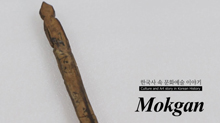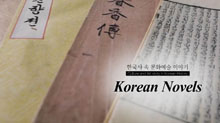The Story of Culture and Arts
- Image resource of Korean history
- Documents from History TextBooks
- Culture & Art Stories from Korean History
- Culture & Art Stories from Korean History - Korean
- National Institute of Korean History
- History net
- About the site
- Introduce
-
Numerous topics related to Korean culture and art are mentioned in middle and high school national history textbooks, but most of them are briefly described by era, making it difficult to understand their concepts, transition processes, and characteristics.
<Culture & Art Stories from Korean History> produces and provides video materials based on expert commentary on the flow, change process, characteristics and characteristics of each major topic in the field of culture and art in Korean history.

Scenario
Every day, we write things down. We take notes during class, or write down the recipe for a dish, all so we don’t forget.
But, when paper was so hard to come by, what did our ancestors use to write things down?
Let me introduce an exceptional relic used by the people to record daily events during a time when paper was scarce, the mokgan.
When Paper Was Hard to Find, There was the Mokgan
Along the grassy meadows of this mountainside lie the remnants of a stone city wall. This wall is the Haman Seongsan Mountain Fortress.
It was at this point, under the eastern wall of the fortress, that over 300 strips of wood were excavated. What could these stips of wood possibly be?
The excavated strips of wood discovered will first be restored and then preserved with great care.
The fully restored strips of wood are placed under a UV light, where they surprisingly reveal brush strokes in the shape of writing.
The rank of “Geopbeolseong,” the name “Mun Si-i,” as well as the word “peas” along with its grammatical counter can be seen written in Chinese characters.
Once strung together, these three words can be interpreted that a man named Mun Si-i, from present-day Yeongju in Gyeongsangbuk-do Province, and holding the rank of geopbeolseong, sent peas.
Slips of wood like these with characters and words carrying information are called mokgan.
So, why were these mokgan found at Seongsan Sanseong Fortress in Haman?
“After the mid 6th century, Seongsan Mountain Fortress was built, and while it was occupied, there was a great need for supplies to come in and out.” Lee Jaehwan, Professor / Chung-Ang University, Dept. of History
But how is it that these sixth-century Silla Dynasty mokgan were able to survive 1,500 years with their characters so clearly intact?
“It’s because the mokgan were at the subsoil level. At this level, a lot of water can seep in. This creates an environment that locks out oxygen. Since the mokgan were down here, they could go a thousand years without decaying. We think this is how they were able to maintain their original condition up to this day.” Yang Sukja, Chief of Academic Research / Gaya National Research Institute of Cultural Heritage
When paper was precious, people used mokgan as a notebook. However, even with the widespread use of paper in the Goryeo period, people still used mokgan.
A large number of mokgan were found in an excavated Goryeo-era ship discovered off the coast of Mado, Taean. These mokgan are similar to those found at the Haman Seongsan Mountain Fortress in that they contain cutouts on each end.
Grooves were made so the mokgan could be wrapped with string and tied to goods like a tag. These were called “tag mokgan,” and acted similar to the shipping labels we use today.
Of all the types of mokgan used, tag mokgan were the most common.
“During the Goryeo and Joseon period, the cost of paper production was fairly high, so most people couldn’t afford to have any. However, since a wood slip could be shaved down with a knife and used over and over again, the mokgan was the primary choice by the general public.” Kim Taekjun, Researcher / National Research Institute of Maritime Cultural Heritage
“Mokgan” – Detailed Records of Daily Life in Ancient Times
Site of Baekje’s Sabi Fortress, Ssangbuk-ri, Buyeo
On the mokgan found here, special numbers are written.
Can you tell what these numbers might be?
It’s a multiplication table, just like the ones we use.
“All the multiples from 2 to 9 are written in order. Between each set is a line to separate the multiples. And in each set, where the number times itself, so 9x9=81, 9x9, 8x8, right after the first number is a special mark(“) so you don’t need to repeat the number. You can also see in each set that the numbers start on the top right-hand side, and as it goes down from 2 to 9, the wood gets narrower and forms a point.” Jung Hoonjin, Team Leader / Korea Cultural Heritage Foundation
The reason for its unique shape is not just to match the arrangement of the multiplication table, but because this shape makes it easier to hold. Upon closer inspection of the edges, we can see how it was shaped to fit one’s hand.
It is likely that multiplication table mokgan were carried around and used by low-level Baekje officials to more accurately calculate numbers.
Mokgan were also excavated at Gyeyang Mountain Fortress in Incheon. These mokgan have five sides, each side containing characters. These are the “Analects of Confucius.” It is thought that the Analects of Confucius mokgan date back to the Unified Silla period.
As the Analects were required reading for the state examinations, these mokgan were likely used by Silla officials for studying.
In the ruins of Silla’s magnificent Donggung Palace, several mokgan were also retrieved from Wolji Pond. The mokgan from Wolji Pond offer us a glimpse of life inside the Silla palace.
Let’s take a look at one of these mokgan. We see the characters “nokgap” for pickled deer and “ong” for jar. This means the jar contained pickled deer. On the front, we can see words stating that it was made on the third day of some month.
Thanks to mokgan, we now know that pickling was also done in the Silla period, and that they made several varieties of pickled goods and labeled them with great detail.
On other mokgan are found prescriptions for medication. The names of medicinal ingredients, like rhubarb and licorice root, as well as their quantities were recorded.
Besides these, mokgan with drawings of faces, or those used to practice writing, have also been excavated. With so many well-preserved accounts of our ancestors, mokgan have increasingly aroused the interest of historians.
“These mokgan are precious documents that record the mundane details of the daily lives of previous generations. Mokgan have recently entered the spotlight as essential documents. They tell us about aspects of the literary culture of the past not found in history books.” Lee Jaehwan, Professor / Chung-Ang University, Dept. of History
Notes describing the simple details of our lives. Could these too become like mokgan and serve as mysterious time capsules to be found by future generations?
[Epilogue]
Must-Know Facts on Culture and Art in Korean History
1. Mokgan were strips of wood that served to relay information by having characters recorded on them.
2. Mokgan were considered an important form of stationery since paper was scarce at that time.
3. Mokgan recorded important clues about the lives of the common people.





